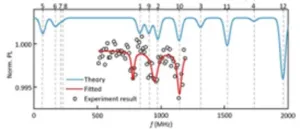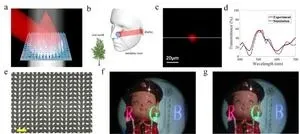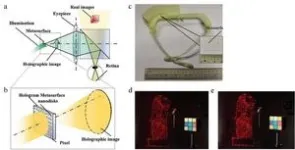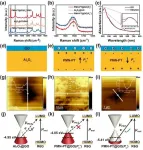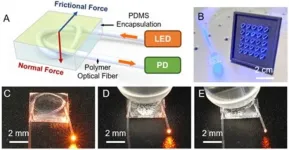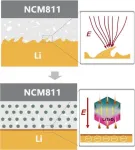(Press-News.org) Teams led by Prof. DU Jiangfeng, Prof. SHI Fazhan and Prof. KONG Fei from the University of Science and Technology of China (USTC) of the Chinese Academy of Sciences (CAS) used the Nitrogen-Vacancy (NV) center inside a single nanodiamond for quantum sensing to overcome the problem of random particle rotation.
The study was published on Oct. 7th in Nature Communications.
It is an important goal to detect and analyze molecules under physiological in situ conditions in the field of life sciences. Only by observing biomolecules under this condition can we reveal conformation changes when they realize physiological functions.
Thanks to its high sensitivity, good biocompatibility, and the characteristics of magnetic resonance detection of single molecules at room temperature atmosphere, the NV center quantum sensor is rather suitable for physiological in situ detection than traditional magnetic spectrum resonance instruments.
However, the results of tracking the movement of nanodiamond in living cells show that it rotates randomly both inside the cell and on the cell membrane, making the current common magnetic resonance detection methods ineffective.
To solve this problem, the research team designed an amplitude-modulation sequence, which will generate a series of equally spaced energy levels on the NV center.
When the energy level of the NV center matches the energy level of the measured target, resonance will occur and the state of the NV center will change.
By scanning the modulation frequency, the electron paramagnetic resonance (EPR) spectroscopy of the target can be obtained, and the position of the spectral peak is no longer affected by the spatial orientation of the NV center.
In this work, the ions in the solution environment of nanodiamond were measured by EPR spectroscopy under the condition of in situ. The research team simulated the movement of nanodiamonds in the cell to detect the solution of oxygen vanadium ions.
When there is rotation of nanodiamond, it is difficult to conduct accurate quantum manipulation of NV centers, but zero-field EPR spectrum of oxo-vanadium ions can still be measured.
This result proves in principle that it is feasible to use NV center in nanodiamond to realize the detection of intracellular physiological in-situ magnetic resonance.
The oxygen vanadium ions detected in this work itself have biological functions. The ultra-fine constant of oxygen vanadium ions can be analyzed and obtained by the EPR spectrum measured by a single moving nanodiamond.
The research team has previously relaxed the detection conditions of single-molecular magnetic resonance detection from solid conditions to aqueous solution environment, and this work has further promoted it to the in situ environment.
END
The USTC realizes In situ electron paramagnetic resonance spectroscopy using single nanodiamond sensors
2023-11-03
ELSE PRESS RELEASES FROM THIS DATE:
Men less likely than women to share negative information, says study
2023-11-03
A new study from Carnegie Mellon University, Bayes Business School (formerly Cass), and Bocconi University has found that men are less eager and likely to share negative information than women, while there was little difference when it comes to positive news.
Published in the Journal of Experimental Social Psychology, the authors suggest that this may be due to a greater concern among men over how other people will see them, resulting in a tendency to self-promote by sharing positive information about themselves and not revealing their negative experiences to others.
Dr Erin Carbone, Visiting Assistant Professor in the Department of Social ...
Focus on AR/VR: Near-eye display based on metasurface devices
2023-11-03
A new publication from Opto-Electronic Science; DOI 10.29026/oes.2023.230025 discusses near-eye display based on metasurface devices.
With the rise of the meta-universe, virtual reality (VR) and augmented reality (AR) technologies have been developing rapidly in recent years. Near-eye displays are crucial technologies for VR and AR. Despite the rapid advances in near-eye display technologies, there are still challenges such as large field of view (FOV), high resolution, high image quality, natural free 3D effect, and compact form factor. Great efforts have been devoted to striking a balance between visual performance and device compactness. ...
A review of liquid crystal spatial light modulators devices and applications
2023-11-03
A new publication from Opto-Electronic Science; DOI 10.29026/oes.2023.230026 overviews liquid crystal spatial light modulators devices and applications.
Technology to control and harness light has existed for centuries, often as static solutions that must be custom-designed. It is only in the past couple of decades that the digital era of micro-electronics and computing has seen fast rewritable technology meant for displays find its way into the mainstream of optics. In this review, the authors showcase the recent advances in replacing the traditional static optical toolkit with a modern digital toolkit for “light on demand”. ...
Ferroelectrically modulate the Fermi level of graphene oxide to enhance SERS response
2023-11-03
A new publication from Opto-Electronic Advances, 10.29026/oea.2023.230094 discusses Ferroelectric modulation of the Fermi level of graphene oxide to enhance SERS response.
Surface-enhanced Raman scattering (SERS) is a powerful fingerprint analysis and detection technique that plays an important role in the fields of food safety, environmental protection, bio-imaging and hazardous substance identification. Electromagnetic enhancement (EM) and chemical enhancement (CM) are the two recognized mechanisms of action for amplifying Raman signals. EM originates from the localized surface plasmonic resonance effect of noble metal nanostructures ...
Knot-inspired optical sensors for slip detection and friction measurement in dexterous robotic manipulation
2023-11-03
A new publication from Opto-Electronic Advances, 10.29026/oea.2023.230076 discusses knot-inspired optical sensors for slip detection and friction measurement in dexterous robotic manipulation.
Hands possess an awe-inspiring ability to perceive friction forces with remarkable accuracy, all thanks to the mechanical receptors nestled within skin. This natural gift allows objects to be handled deftly and tools to be wielded effortlessly, infusing daily life with a delightful flexibility. But what if this tactile prowess could be unlocked in robots?
Imagine a world where robots possess the uncanny ability to detect and understand friction and slip, just ...
Bridging the best of both electrolyte worlds for a better lithium-ion battery
2023-11-03
Lithium-ion batteries powered the device on which these words appear. From phones and laptops to electric vehicles, lithium-ion batteries are critical to the technology of the modern world — but they can also explode. Comprising negatively and positively charged electrodes and an electrolyte to transport ions across the divide, lithium-ion batteries are only as good as the limitations of their components. Liquid electrolytes are potentially volatile at high temperatures, and their efficiency can be limited by nonuniformity and instabilities in the other components.
Researchers are working toward developing safer, ...
Rafael De Cabo, Ph.D.(NIH), D.ing Xu, Ph.D. (UConn), and Claire K. Ankuda, MD, MPH, MSC (Mount Sinai Health System) to present lectures at AFAR Scientific Awards Ceremony
2023-11-03
November 3, 2023 -- The American Federation for Aging Research (AFAR), a national non-profit whose mission is to support and advance healthy aging through biomedical research, will host its annual Scientific Awards of Distinction lectures and ceremony on Friday, November 10 from 6:30pm-9:00pm ET in conjunction with the Annual Scientific Meeting of the Gerontological Society of America (GSA) held in Tampa, Florida. In addition to an awards presentation and reception, the honorees will present lectures highlighting their research.
Rafael de Cabo, PhD, will receive the 2023 Irving S. Wright ...
Study on Magnetic Force Microscopy wins 2023 Advances in Magnetism Award
2023-11-03
MELVILLE, N.Y., November 3, 2023 – An examination of the impact of image size on measurements from magnetic force microscopy has won the Advances in Magnetism Award, sponsored by AIP Advances, published by AIP Publishing.
The paper, “Finite image size effects on the characterization of magnetic domain patterns via magnetic force microscopy,” was selected as the winner from nearly 200 papers submitted as part of the 2022 Magnetism and Magnetic Materials conference. Michael Vaka, now a data engineer at Zontal, was awarded a cash prize and a travel stipend to next year’s ...
Press program now available for one of the world’s largest meetings in fluid dynamics
2023-11-03
The annual meeting for the American Physical Society’s (APS) Division of Fluid Dynamics will begin in two weeks with presentations on new research in aerodynamics, turbulence, wind and water power, bubbles, culinary fluid dynamics, medicine, and more. The conference will be held in person at the Walter E. Washington Convention Center in Washington, DC, Nov. 19-21.
There are no press conferences planned for this year’s program. However, a tip sheet highlighting newsworthy presentations is now available in the meeting’s press kit. Registered journalists ...
Wearable devices may prevent astronauts getting 'lost’ in space
2023-11-03
The sky is no longer the limit — but taking flight is dangerous. In leaving the Earth’s surface, we lose many of the cues we need to orient ourselves, and that spatial disorientation can be deadly. Astronauts normally need intensive training to protect against it. But scientists have now found that wearable devices which vibrate to give orientation cues may boost the efficacy of this training significantly, making spaceflight slightly safer.
“Long duration spaceflight will cause many physiological and psychological stressors which will make astronauts very susceptible to spatial disorientation,” ...
